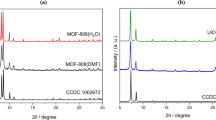Abstract
Organo-mineral derivatives of montmorillonite modified by salts of quaternary ammonium compounds are promising adsorbents for wastewater purification from heavy metal anions, as well as anionic dyes and pesticides. The understanding of the mechanism of anion adsorption by the example of montmorillonite modified by didecyldimethylammonium chloride cationic surfactant is expanded. The high rate of chromium anion adsorption, the appearance of adsorption capacity only during charge exchange of the surface, and the pH dependence of adsorption, including for pH-independent nitrate anions, indicate that a significant contribution to adsorption of anions is made by silanol and aluminol groups on the edge surface of the aluminosilicate layers of the mineral. The redistribution of access to various types of adsorption centers of the surface for adsorptive is the mechanism of inversion of the adsorption properties for montmorillonite. The inner negatively charged surface is screened by the double layer of the surfactant molecules that block the interlayer space. The surfactant molecules are not hydrated, which impedes delamination of the mineral in aqueous medium.






Similar content being viewed by others
REFERENCES
Auerbach, S.M., Handbook of Layered Materials, New York: Marcel Dekker, 2004.
Mukherjee, S., The Science of Clays: Applications in Industry, Engineering, and Environment, New York: Springer-Verlag, 2013.
Fil, B.A., Özmetin, C., and Korkmaz, M., Characterization and electrokinetic properties of montmorillonite, Bulg. Chem. Commun., 2014, vol. 46, no. 2, pp. 258–263.
Avena, M.J., Cabrol, R., and De Pauli, C.P., Study of some physicochemical properties of pillared montmorillonites: acid–base potentiometric titrations and electrophoretic measurements, Clays Clay Miner., 1990, vol. 38, no. 4, pp. 356–362.
Lin, S.-H. and Juang, R.-S., Heavy metal removal from water by sorption using surfactant-modified montmorillonite, J. Hazard. Mater., 2002, vol. 92, pp. 315–326.
Akl, M.A., Youssef, A.M., and Al-Awadhi, M.M., Adsorption of acid dyes onto bentonite and surfactant-modified bentonite, J. Anal. Bioanal. Technol., 2013, vol. 4, no. 4. https://doi.org/10.4172/2155-9872.1000174
Muir, B., Andrunik, D., Hyla, J., and Bajda, T., The removal of molybdates and tungstates from aqueous solution by organo-smectites, Appl. Clay Sci., 2017, vol. 136, pp. 8–17.
Atia, A.A., Adsorption of chromate and molybdate by cetylpyridinium bentonite, Appl. Clay Sci., 2008, vol. 41, pp. 73–84.
Krishna, B.S., Murty, D.S.R., and Jai Prakash, B.S., Surfactant-modified clay as adsorbent for chromate, Appl. Clay Sci., 2001, vol. 20, pp. 65–71.
Ma, J., Cui, B., Dai, J., and Li, D., Mechanism of adsorption of anionic dye from aqueous solutions onto organobentonite, J. Hazard. Mater., 2011, vol. 186, pp. 1758–1765.
Sarkar, B., Xi, Y., Megharaj, M., Krishnamurti, G.S.R., et al., Remediation of hexavalent chromium through adsorption by bentonite based Arquad® 2HT-75 organoclays, J. Hazard. Mater., 2010, vol. 183, pp. 87–97.
Boddu, V.M., Abburi, K., Talbott, J.L., and Smith, E.D., Removal of hexavalent chromium from wastewater using a new composite chitosan biosorbent, Environ. Sci. Technol., 2003, vol. 37, pp. 4449–4456.
Ammann, L., Bergaya, F., and Lagaly, G., Determination of the cation exchange capacity of clays with copper complexes revisited, Clay Miner., 2005, vol. 40, pp. 441–453.
Arnold, E.G., Lenores, S.C., and Andrew, D.E., Standard Methods for the Examination of Water and Wastewater, Washington, DC: Am. Publ. Health Assoc., 1992.
Mironov, V.A. and Yankovskii, S.A., Spectroskopiya v organicheskoi khimii (Spectroscopy in Organic Chemistry), Moscow: Khimiya, 1985.
Plyusnina, I.I., Infrakrasnye spectry mineralov (Infrared Spectra of Minerals), Moscow: Mosk. Gos. Univ., 1977.
Chukanov, N.V., Infrared Spectra of Mineral Species: Extended Library, New York: Springer-Verlag, 2014, vol. 1.
Author information
Authors and Affiliations
Corresponding authors
Additional information
Translated by L. Mukhortova
Rights and permissions
About this article
Cite this article
Kon’kova, T.V., Rysev, A.P. & Mishchenko, E.V. Mechanism of Inversion of Montmorillonite Sorption Properties by Cationic Surfactant. Inorg. Mater. Appl. Res. 11, 1110–1115 (2020). https://doi.org/10.1134/S2075113320050184
Received:
Revised:
Accepted:
Published:
Issue Date:
DOI: https://doi.org/10.1134/S2075113320050184




